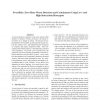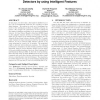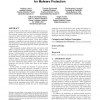496 search results - page 46 / 100 » The use of computational intelligence in intrusion detection... |
PERVASIVE
2005
Springer
14 years 1 months ago
2005
Springer
Abstract. Embedded assessment leverages the capabilities of pervasive computing to advance early detection of health conditions. In this approach, technologies embedded in the home...
CN
2007
13 years 8 months ago
2007
As next-generation computer worms may spread within minutes to millions of hosts, protection via human intervention is no longer an option. We discuss the implementation of SweetB...
CONEXT
2007
ACM
13 years 9 months ago
2007
ACM
Network intrusion detection systems typically detect worms by examining packet or flow logs for known signatures. Not only does this approach mean worms cannot be detected until ...
GECCO
2008
Springer
13 years 9 months ago
2008
Springer
In this paper, we show that a Bio-inspired classifier’s accuracy can be dramatically improved if it operates on intelligent features. We propose a novel set of intelligent feat...
CCS
2010
ACM
13 years 8 months ago
2010
ACM
Models based on system calls are a popular and common approach to characterize the run-time behavior of programs. For example, system calls are used by intrusion detection systems...



